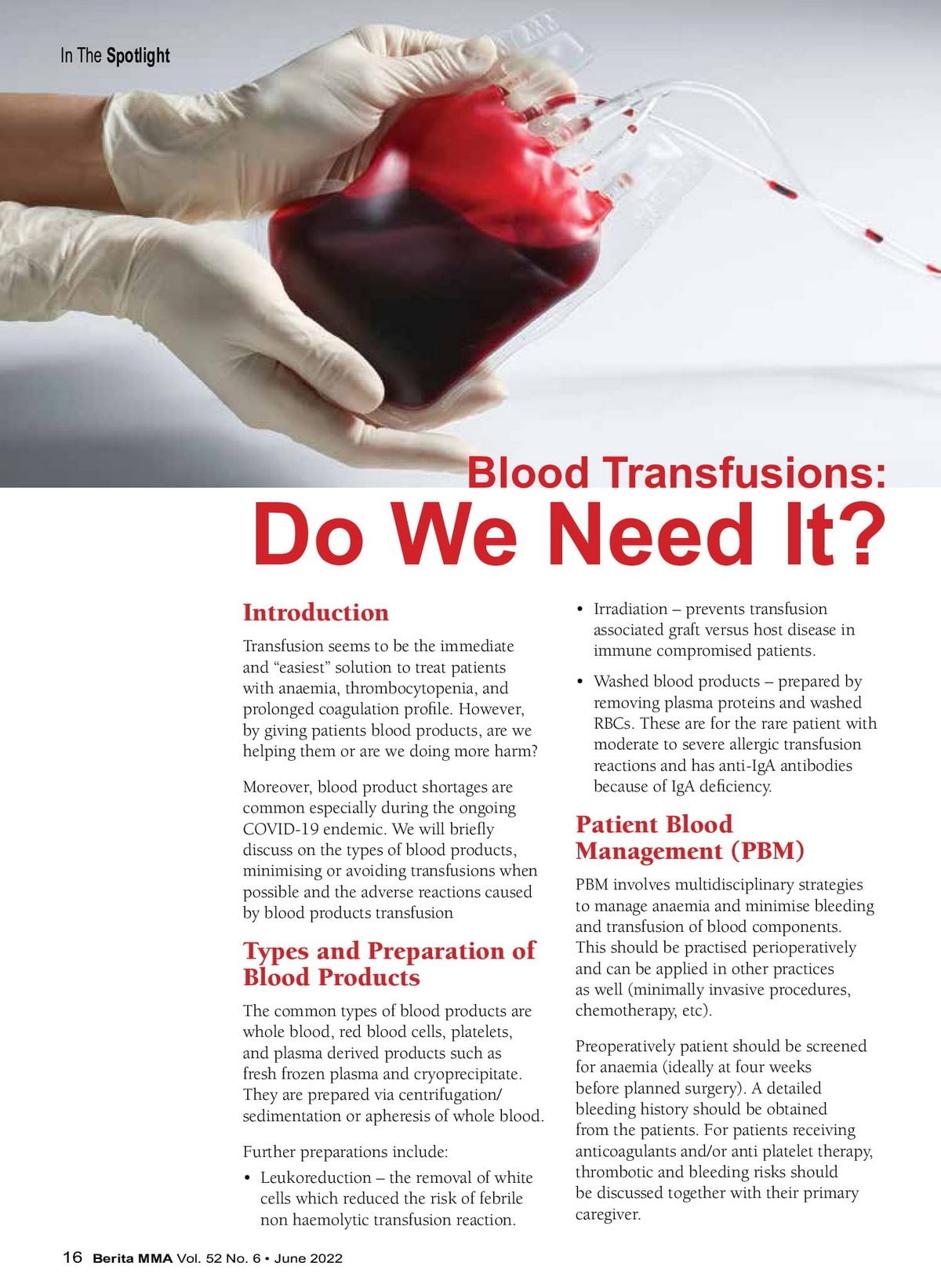
Contents
Whole Blood
Whole blood is collected from donors and contains all blood components. It is primarily used for transfusion in adults with massive blood loss and active bleeding, who require all blood components. Whole blood may also be reconstituted using stored plasma, red blood cells (RBCs), and platelets for cardiovascular surgeries and exchange transfusions in newborns.
Fresh whole blood is not commonly used in most of the U.S. Whole blood is now mainly used for autologous transfusion during or after elective surgery. It provides all necessary components to control bleeding in rapidly hemorrhaging patients.
Warnings
- Only use whole blood transfusions when a specific blood component is not available. Whole blood can cause complications in patients who only require a specific component.
- Match the ABO blood group to the recipient and only use the identical group for transfusion, because whole blood contains plasma and red blood cells.
- Store whole blood at 4 degrees C, and it has a 21-to-35-day expiration depending on the anticoagulant solution used.
- Whole blood may be deficient in clotting factors V and VIII unless it is fresh because these factors degrade rapidly during refrigerated storage.
- Platelets undergo conformational changes with short-term refrigerated storage and are unlikely to be beneficial since whole blood is stored at 4 degrees C.
- Do not delay transfusion waiting for reconstituted whole blood in emergency situations because reconstitution is time-consuming.
- Use blood administration sets containing filters for whole blood transfusions. Do not administer other fluids with whole blood without consulting the medical director of the blood bank.
- Monitor patients for signs of transfusion reaction before, during, and after whole blood transfusion. If a transfusion reaction is suspected, stop the transfusion, assess and stabilize the patient, and notify the blood bank.
- Massive or rapid transfusion of whole blood may lead to various complications.
- Monitor for iron overload in chronically transfused patients with hemoglobinopathies.
- Whole blood transfusions carry the risk of non-septic infections.
- Consult with the medical director of the blood bank or a hematologist for special transfusion requirements.
QUESTION
What are the side effects of whole blood?
Common side effects of whole blood include:
- Hemolytic transfusion reactions that destroy red blood cells
- Feverish (febrile) non-hemolytic reactions
- Transfusion-associated circulatory overload (TACO)
- Transfusion-related acute lung injury (TRALI)
- Transfusion-transmitted infections and septic reactions
- Transfusion-associated graft-versus-host disease (TA-GVHD)
- Allergic reactions such as:
- Hives (urticaria)
- Itching (pruritus)
- Wheezing
- Shortness of breath (dyspnea)
- Low blood pressure (hypotension)
- Swelling under the skin and mucous membrane (angioedema)
- Respiratory distress
- Shock
Call your doctor immediately if you experience any of the following symptoms or serious side effects:
- Serious heart symptoms include fast or pounding heartbeats, fluttering in your chest, shortness of breath, and sudden dizziness;
- Severe headache, confusion, slurred speech, severe weakness, vomiting, loss of coordination, feeling unsteady;
- Severe nervous system reaction with very stiff muscles, high fever, sweating, confusion, fast or uneven heartbeats, tremors, and feeling like you might pass out; or
- Serious eye symptoms include blurred vision, tunnel vision, eye pain or swelling, or seeing halos around lights.
This is not a complete list of all side effects or adverse reactions that may occur. Call your doctor for medical advice about serious side effects or adverse reactions. You may also report side effects or health problems to the FDA at 1-800-FDA-1088.
What are the dosages of whole blood?
Adult:
Acute Hemorrhage
- Dosing should be based on the patient’s condition, estimated blood loss, and other measures to maintain hemodynamic stability.
Other Information
- Whole blood is not commonly used in most of the United States.
- The most common use of whole blood in the United States is for autologous donations during elective surgery.
- Whole blood may be indicated for large volume hemorrhaging requiring massive transfusion and rapid correction of anemia, coagulopathy, acidosis, and hypothermia. Fresh whole blood is not routinely available in civilian institutions.
- Reconstituted whole blood is used for neonatal exchange transfusions and pediatric cardiovascular surgery and hemodialysis.
Pediatric:
Exchange Transfusions
- Consult with the blood bank medical director or hematologist for dosing of reconstituted whole blood.
- Predefined dosing protocols should be setup for cardiovascular surgery or hemodialysis based on the procedure and cardiopulmonary circuits used.
Overdose
- Excessive transfusion of whole blood can result in circulatory overload. Symptoms include fluid in the lungs, acute respiratory distress, increased blood pressure, and rapid heart rate.
- Treatment for transfusion overload may include diuretic administration, removal of excess fluid by hemodialysis, and other supportive measures.
What drugs interact with whole blood?
Inform your doctor of all medications you are currently taking to check for possible drug interactions.
- Whole blood has no known severe, serious, moderate, or mild interactions with other drugs.
The drug interactions listed above are not all of the possible interactions or adverse effects. For more information on drug interactions, visit the RxList Drug Interaction Checker.
Always inform your doctor, pharmacist, or health care provider of all medications you use, along with the dosage for each. Keep a list of this information. Check with your doctor or health care provider if you have any questions about the medication.
Pregnancy and breastfeeding
- Whole blood may be used for transfusion in pregnant women with active bleeding before, during or after delivery.
- Use CMV-seronegative or CMV reduced risk red blood cells in pregnant or breastfeeding women who are CMV-seronegative or whose CMV status is unknown.
By clicking Submit, I agree to the MedicineNet’s Terms & Conditions & Privacy Policy and understand that I may opt out of MedicineNet’s subscriptions at any time.
Summary
Whole blood is collected from donors and contains all blood components. It is primarily used for transfusion in adults with massive blood loss and active bleeding, who require all blood components. Whole blood may also be reconstituted using stored plasma, red blood cells (RBCs), and platelets for cardiovascular surgeries and exchange transfusions in newborns. Common side effects of whole blood include hemolytic transfusion reactions, hives (urticaria), itching (pruritus), wheezing, shortness of breath (dyspnea), low blood pressure (hypotension), and serious allergic (anaphylactic) reactions.
Whole blood is collected from donors and contains all blood components. It is primarily used for transfusion in adults with massive blood loss and active bleeding, who require all blood components. Whole blood may also be reconstituted using stored plasma, red blood cells (RBCs), and platelets for cardiovascular surgeries and exchange transfusions in newborns. Common side effects of whole blood include hemolytic transfusion reactions, hives (urticaria), itching (pruritus), wheezing, shortness of breath (dyspnea), low blood pressure (hypotension), and serious allergic (anaphylactic) reactions.


